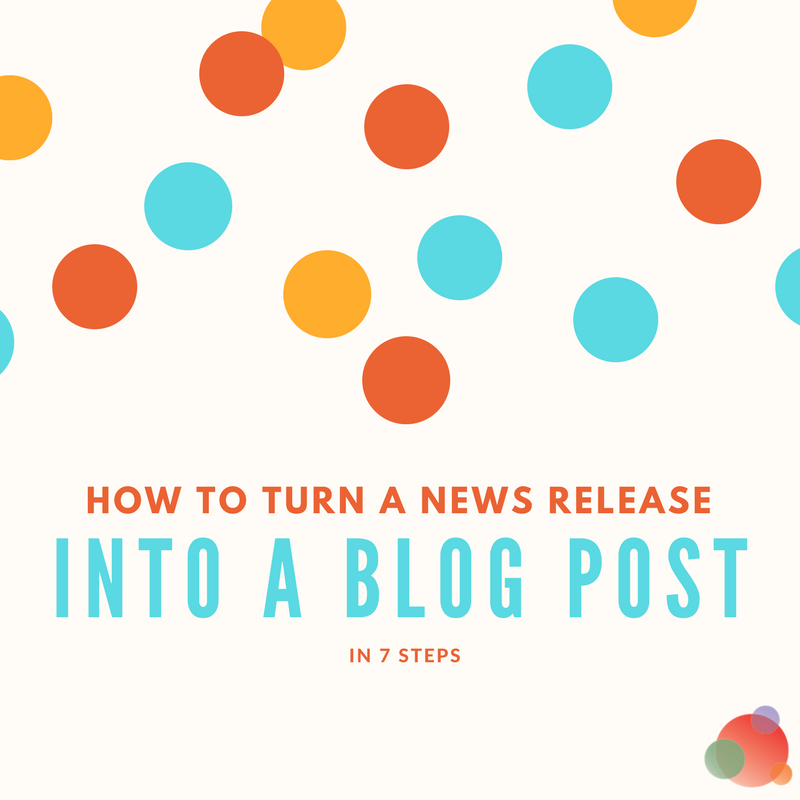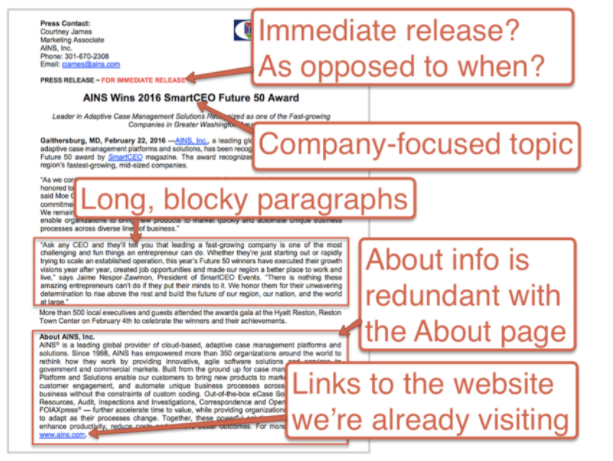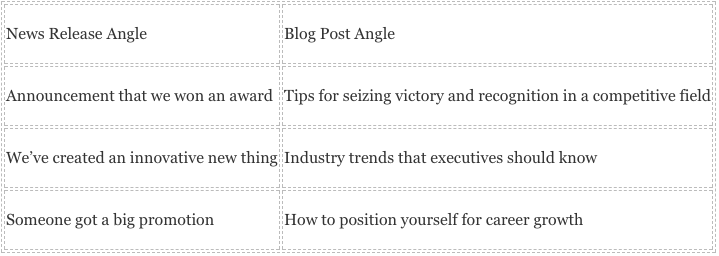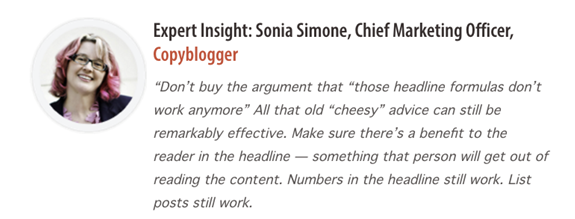 A news release is content, but it isn’t content that works well on a website.
A news release is content, but it isn’t content that works well on a website.
News releases get posted to websites every day, but they aren’t intended for that purpose.
Consider the difference between a news release and a blog post:
- You create a news release for members of the media. Its goal is to announce something that is ostensibly newsworthy, so the media may cover it as news. You should write about this. Your readers would like this.
- You create a blog post for a broad range of possible website visitors. Its goal is to attract that audience and then inspire them to take action, such as subscribe, share, comment, mention, and link. These actions, directly and indirectly, create brand awareness and generate demand. You should read this. It’s useful to you.
Big difference, right?
Different audience.
Different goals.
So it’s easy to see why news releases make for bad web content.
They don’t align with the goals of most website visitors.

To turn a news release into a great piece of content that works for the majority of our visitors, we need to adapt it.
It might be close to great web content already, but we can make it better.
Here are seven ways to turn a news release into an effective blog post.
Give it a Practical Twist
What’s in it for me?
That’s what you’d hear if you were in the heads of every visitor on every webpage.
Before your visitors click to see your new post, they do a split second cost/benefit analysis in their heads.
The key is to give the post an angle that offers value, not just information.

In each case, the announcement from the news release is simply an example supporting a larger message.
The context has shifted, and the value to the reader has spiked.
Go deeper: 6 Essential Tips to Create More Valuable Content
Nail the (Benefit-Driven) Headline
Here’s where you sell that practical angle.
When they see the headline in a social stream, a search results page, or their inbox, they ask themselves this question: will my investment of time in this article give me a return?
What are the benefits of clicking on this link?
We have to indicate the benefits immediately in the headline.
Ideally, at the beginning of the headline!
To nail your new headline, try some of these techniques:
- The more specific the benefits, the more clicks and traffic you’ll see.
- If you used a number in the news release, put it into the headline, especially if it indicates a number of points. In other words, make it a list.
- Write at least 10 headlines before choosing one.
Go deeper: The Step-by-Step Guide to Writing Powerful Headlines
Images
News releases aren’t visual.
But every great blog post has a great image.
Content with images gets shared more and clicked more.
Just make it a rule: never publish a piece of content without an image.
- Use an image of people, if possible.
- Consider adding text to the image, overlaying the headline right onto the visual.
- Keep going with visuals. Add images throughout the post. Ideally, there is no scroll-depth at which there isn’t at least one image.
Go deeper: All the Things We Did Wrong with Blog Images
Drill Down into the Details
The original news release is an announcement.
But visitors to your website are expecting more than a short page with an FYI.
Take the time to go into the details.
- Does the news release imply or assume anything? Turn the assumption into a question then write a paragraph with an answer.
- Is there a practical, how-to angle related to the topic? List the steps involved in that process.
- Build up the value until you pass the 1,000-word mark.
Go deeper: Why You Should Create Long-Form Content (and How to Do It)
Connect to Other Content through Links
News releases link to the company that wrote it, but little else.
But blog posts, good ones, link to many things.
It’s key to the craft.
Blogging is linking.
Here are five types of links to consider:
- Another of your articles.
- A product or service page (but never the home page).
- Any resource on any site that supports your article.
- Any contributors or influencers who are in the article. We’ll go into this in a minute…
- FROM an older post to this new piece once it goes live.
Your new piece isn’t an island. It will be part of an interconnected set of articles.
Go deeper: The 7 Commandments of Internal Linking that Will Improve Content Marketing SEO
Gather and Mention Sources
If your news release had been a hit, it would be covered by the media, making you the source.
But we’re writing the piece now.
We are the media.
So we’ll need sources to help make our case.
Think of an expert whose contribution would make this a better piece.
This is an influencer whom your audience likes and trusts.
Here are general guidelines for including them:
- If you already know of a quote, just add it. Better yet, reach out and ask for something original and specific to the piece.
- Keep it short, direct and relevant, exactly has a journalist would
- If possible, add their face, name, title, company, and link. This will make their quote more credible and make your piece more personal.
Here’s an example:

Once the post is live, let them know that they’re in it by mentioning them when you share it on social
Collaboration is key to content.
Not only will these contributors and co-creators make our post stronger, but they’ll help drive a little traffic if you remind them to share it once it’s published.
Go deeper: A Guide to Collaborative Content
Web-Friendly Formatting
News releases were not meant to be website content, so it’s not surprising they miss many opportunities to align with expectations of visitors.
Here’s a list of things news releases often do, but blog posts do not.
You can start by removing these:
- The header. “For immediate release” means nothing on the internet.
- Formatting. You don’t want this to look like it rolled off a typewriter. Add subheads, bullet lists, bolding, italics, and anything else that make it scannable.
- Long paragraphs. On the web, we should avoid writing paragraphs longer than three to four lines.
- The “About Company” and “Contact” information. These are on other pages. No need to put them here.
Visitors to pages tend to scan, not read.
By removing anything unnecessary and making the rest easy to scan, we tune our content for performance on the web.
Go deeper: Must-Have Checklist to Creating Valuable Content
So What About the Original News Release?
Yes, it is possible a journalist will visit your website, looking for your latest releases with the hopes of covering you.
Probably this is a tiny fraction of your total visitors, which is why a “media” section is typically one of the lowest traffic areas of any website.
If you want to post the original, go right ahead, but don’t expect it to get visited, read, or shared.
Don’t expect it to trigger subscribers or comments.
There is no harm in putting a news release on a website.
But it doesn’t help either, at least not compared to a high-value, practical blog post.
Go deeper: No One Cares About Your News Release and 7 Ways to Launch a Product without a News Release